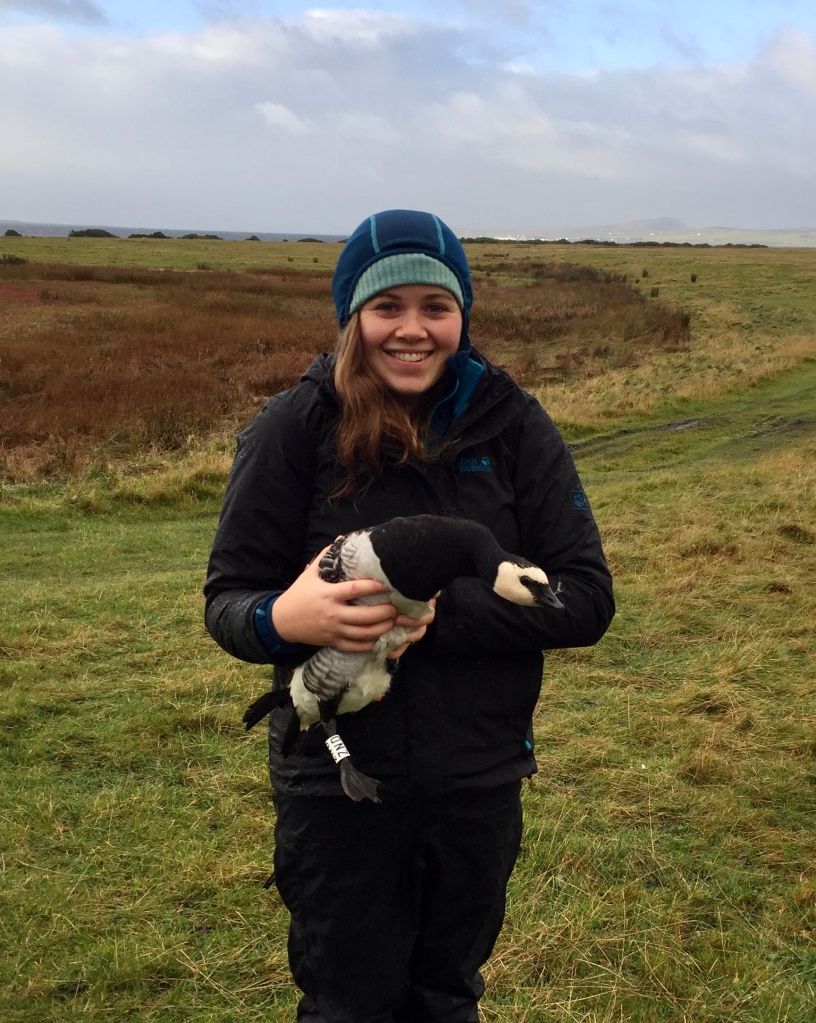Shortlisted for the 2023 Southwood Prize
Aimée McIntosh talks us through how she and colleagues constructed an integrated population model to assess the cumulative impact of all shooting harvest on the Greenland barnacle goose. Findings demonstrate the impact of local harvests on global abundance, emphasising the importance of internationally coordinated monitoring and management strategies of migratory species.
From conservation success to conflict
Unlike many migratory species, numerous North American and European goose populations have undergone substantial increases in abundance in recent decades. This has been attributed to successful conservation efforts such as controls on hunting and creation of refuges. Geese have also benefited from the expansion of agricultural grassland which provides abundantly available, high-quality food. However, this increase in abundance and preference for agricultural grazing has resulted in conflict with farmers. Consequently, many local-scale management strategies include lethal control through culling or recreational hunting to try and reduce these conflicts.
Lethal control of populations requires careful monitoring to prevent over exploitation. Migratory species poses a particularly difficult management challenge as their overall population dynamics can be influenced by different environmental and management conditions at stages throughout the migratory route.
The impact of local shooting activities may therefore not be confined to the targeted local population but may accumulate across the migratory corridor and have implications for population dynamics for the entire population. Understanding the cumulative impact of all localised management strategies can be further complicated owing to differences in the quality and availability of monitoring data throughout the flyway.
Integrated population models (IPMs) provide a modelling approach capable of integrating multiple types of data from across monitoring schemes. This offers a framework to better understand changes in population abundance and dynamics at a flyway-scale required to implement effective flyway-scale management.
A flyway-scale management plan for the Greenland barnacle goose
In this study, we collated key demographic monitoring data from sites throughout the flyway to develop an IPM for the east-Greenland flyway population of barnacle geese (Branta leucopsis). Goose agricultural conflict has long been experienced throughout this species’ migratory flyway and The European Goose Management Platform, established under the African-Eurasian Waterbird Agreement (AEWA) has developed a flyway-scale management approach as part of the International Single Species Management Plan, consequently understanding the population dynamics and the impact of shooting is crucial to inform how strategies should be implemented. To address this, in this work we assessed the cumulative impact of historic local-scale harvest on the overall flyway abundance. In addition, we provide a framework to project the impact of different harvest quotas on the population in the future.
We found that increased harvest of barnacle geese combined with low productivity has coincided with declining abundance since 2012. Increasing shooting pressure on the key wintering site of Islay on the west-coast of Scotland, appears to be associated not only with changes in local abundance, but also in the decline in overall flyway-scale abundance as this decline coincides with changes in local-scale shooting management.
Our study demonstrates the impact that management at specific sites can have on the wider population and emphasises the need for internationally coordinated management and monitoring. We provide a framework that can be adapted in the future as more information becomes available. Additionally, the IPM developed here can be used to improve our understanding of how future harvest strategies may impact overall population dynamics in order to inform local harvest regimes and quotas in order to support the AEWA (Afro-Eurasian Waterbird Agreement) Adaptive Flyway Management Plan.
About the author
This work was the first published as part of my PhD and it was a great opportunity to collaborate and work with all the co-authors and organisations responsible for the management of this flyway.
I was awarded my PhD in 2022 and remained at the University of Exeter for my current position as a post-doctoral researcher.
My current research is still focussed on migratory species and assessing the drivers of change in these complex ecological systems.
Read the full article “Modelling harvest of Greenland barnacle geese and its implications in mitigating human–wildlife conflict“ in Journal of Applied Ecology.
Find the other early career researchers and their articles that have been shortlisted for the 2023 Southwood Prize here!





